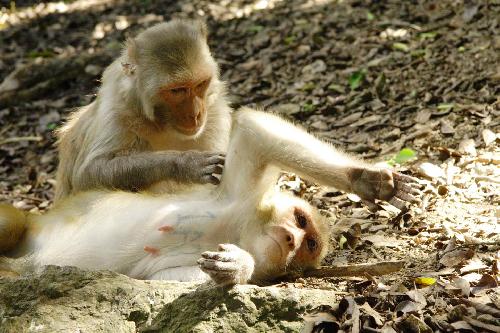The amygdala, a small structure at the front end of the brain's temporal lobe, has long been associated with negative behaviors generally, and specifically with fear. But new research shows this collection of nuclei can also influence positive social functions like kindness and what might be called charitable giving in humans.

To make this discovery about the amygdala, Platt and his team looked at the social behavior of rhesus macaques, a non-human primate species he has studied for 22 years both in the lab and in the wild, on an island off of Puerto Rico called Cayo Santiago.
"What we're trying to do is both identify and understand the basic brain mechanism that allows us to be kind to each other and to respond to the experiences of other individuals," said Michael Platt of the University of Pennsylvania. "We're also trying to use that knowledge to evaluate potential therapies that could improve the function of these neural circuits, especially for those who have difficulty connecting with others."
The researchers incorporated a task they developed four years ago as a way to observe how animals make beneficial decisions, a process Platt described as a reward-donation task.
"We have an actor monkey and a recipient monkey. The actor monkey learns that different-colored shapes on the screen are associated with a reward that can be delivered to himself, to the monkey next to him, to both or to nobody at all," he said. "They learn that over a couple of weeks."
Once the researchers determine the monkeys understand the task, based on how quickly the macaques respond to the rewards, they then present the actor monkey with choices and their accompanying potential rewards. The primates can keep the reward (in this case, a squirt of juice), share it, give it away or let it go to waste.
"Generally our actor monkeys prefer to reward the other monkey rather than let it go unclaimed," Platt said. Relationship status matters, too. "They are more likely to give to those they're more familiar with," he added, "and also to monkeys subordinate to them. The social relationships shape how prosocial the actor monkeys are."
Simultaneous to watching the monkeys' behavior, Platt and his colleagues recorded the neural activity of the amygdala of each animal, to note any correlations between what's happening in the brain and their outward actions. They found that neural activity in the amygdala reflected the value of the recipient's reward in the same way it reflected the value of the reward for the actor. The scientists could predict when actors would give rewards to the recipients based on these neural responses.
When oxytocin was introduced, behaviors changed rapidly. Oxytocin is a hormone linked to social bonds between individuals. In animals, it's been shown to create strong ties between mother and offspring, as well as male and female partners in certain monogamous animals. Though not definitive, research on how oxytocin affects humans has, in some cases, shown to help those with autism better read and understand social cues.
"We don't really know how it works in people. It's very difficult to study. When people inhale oxytocin, there is a change in blood flow to the amygdala, which we think might be involved in making people kinder and more receptive to others," Platt said. In his experiment, the monkeys receiving oxytocin became more willing to give to other monkeys and paid more attention to them after offering the rewards.
Rhesus macaques offer a valuable comparison to humans because the animals model many of the social behaviors in which humans engage. They also live in large social groups and form what Platt described as long-term social bonds.
"Not only with relatives but non-relatives, too. You can think of these as friendships or alliances, and they work hard to maintain them," he said. "Just like humans, the stronger these bonds the monkeys have, the more successful they are. Monkeys with more friends and better friends live longer and have more offspring."
Thanks to funding from the Simons Foundation, the next phase of this research will focus on the part of the brain that identifies social context, for example, determining who is nearby, for what reason and what effect each decision will have on them.
Published in Proceedings of the National Academy of Sciences.





Comments